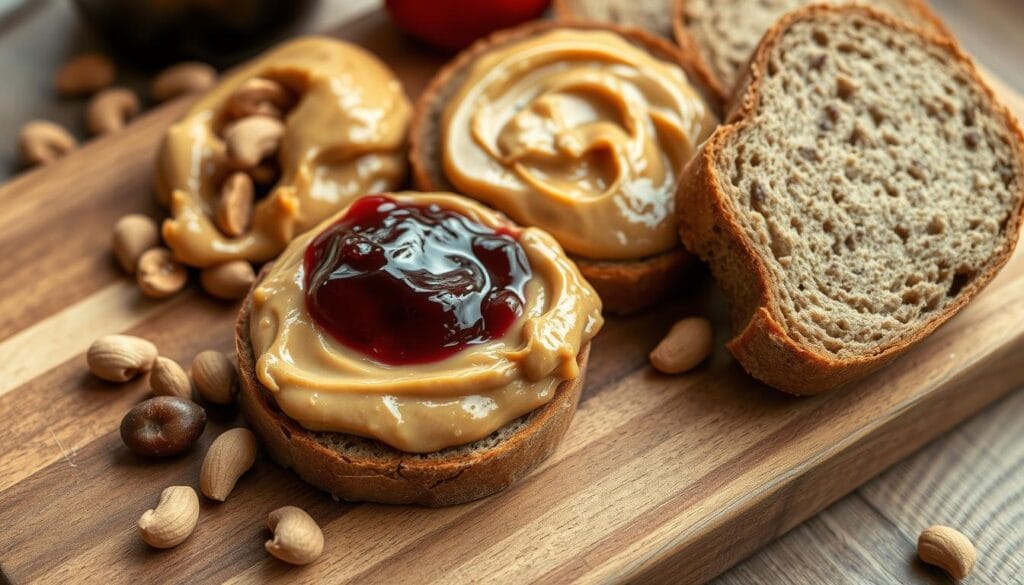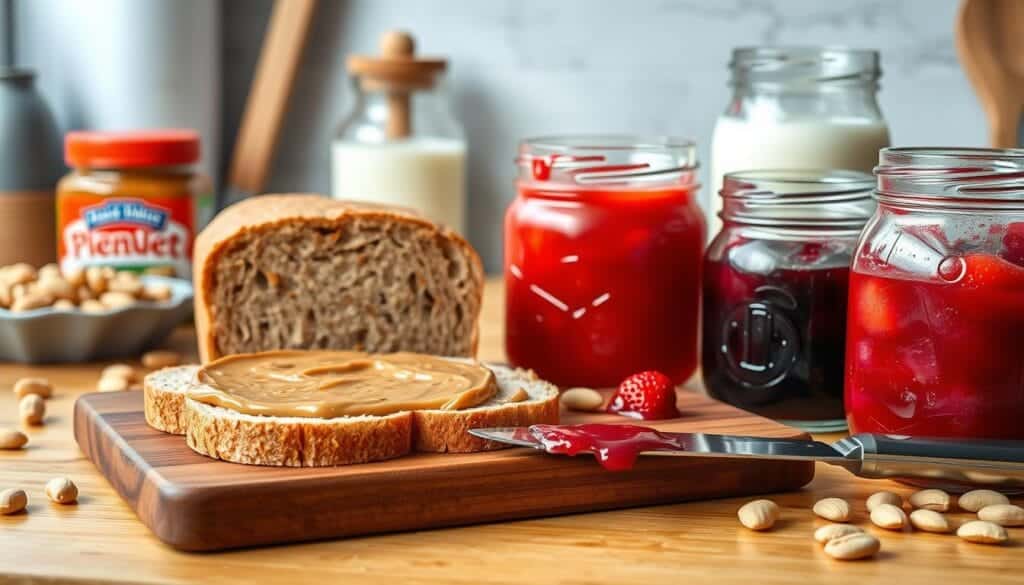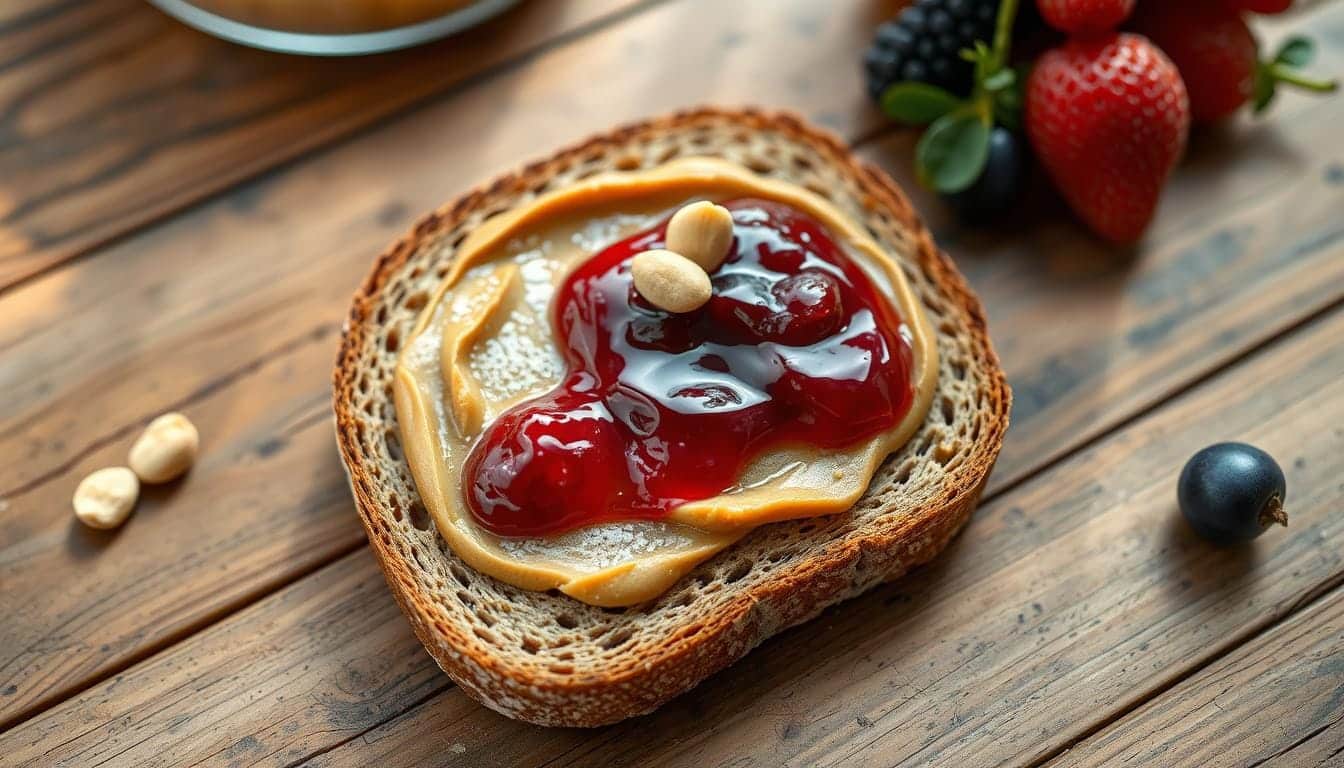The classic peanut butter and jelly sandwich is loved by all ages. This bread grain version is a healthier twist that keeps the nostalgic taste. It uses whole grain bread, making it a nutritious and satisfying snack for everyone.
The first mention of a peanut butter and jelly sandwich was in 1901. Today, it’s a favorite in many homes. In fact, almost all Americans have peanut butter at home. Making this classic into a healthier snack with whole grain bread is easy and delicious. For a deeper dive into the cultural significance of peanut butter and jelly sandwiches and their evolution as a staple snack, explore this insightful study on JSTOR.
The History and Cultural Significance of Peanut Butter and Jelly Sandwiches
The peanut butter and jelly sandwich is a beloved part of American food culture. It’s known for its simplicity and comfort. It brings back happy memories for both kids and adults.
The Origin of Peanut Butter and Jelly
The first mention of a peanut butter and jelly sandwich was in 1901. It became popular during World War II. Soldiers loved it because it was easy to make and lasted a long time.
After the war, it became a favorite lunchtime snack. The 1980s saw its popularity soar. This was thanks to affordable, store-bought ingredients.
Historical Importance of Bread
Bread has been a key part of our diet for thousands of years. It’s perfect for holding spreads like peanut butter and jelly. The Peanut Butter and Jelly sandwich is a modern take on this classic.
The early 20th century brought pre-sliced bread. Mass-produced peanut butter made the sandwich a staple. It was easy and convenient.
Emotional and Nostalgic Connections
The peanut butter and jelly sandwich holds a special place in many hearts. It’s a favorite from childhood. A 2002 survey found that Americans eat about 1,500 Peanut Butter and Jelly sandwiches before they graduate.
It’s not just a personal memory. It’s also a cultural icon. Every April 2, we celebrate National Peanut Butter and Jelly Day.
| Aspect | Details |
|---|---|
| First Known Reference | Boston Cooking School Magazine, 1901 |
| Calories per Serving | 320 kcal (1340 kJ) |
| National Holiday | National Peanut Butter and Jelly Day, April 2 |
| Average Consumption Before High School | 1,500 sandwiches |
Choosing the Best Whole-Grain Bread
Choosing the right bread is key to a great whole wheat Peanut Butter and Jelly sandwich. Whole-grain breads add texture, flavor, and health benefits. Knowing which grains to pick can make your sandwich better.
Popular Bread Grain Options
There are many whole grain bread recipes out there. But, picking the best one means knowing the different grains:
- Whole Wheat: It has a nutty taste and a dense texture, perfect for a whole wheat Peanut Butter and Jelly sandwich.
- Multigrain: It mixes grains like oats, barley, and millet for a rich flavor and texture.
- Oat Bread: Soft and slightly sweet, oat bread balances the savory parts of the sandwich.
Nutritional Benefits of Whole-Grain Bread
Whole-grain bread is packed with nutrients that refined grains lack:
- High in Fiber: It supports healthy digestion.
- Vitamins and Minerals: It has B-complex vitamins, iron, and magnesium for overall health.
- Lower Glycemic Index: Its complex carbs keep blood sugar stable.
A recipe like the Multigrain Bread Recipe is a great example. It has a 4.65 out of 5 rating and serves 24 slices. It uses oatmeal, chia seeds, poppyseeds, and sunflower seeds for a nutritious sandwich base.
| Ingredient | Quantity |
|---|---|
| Yeast | 1 ½ tablespoon |
| Sugar | 2 teaspoons |
| Warm Water | 2 cups |
| Raw Honey | 1/2 cup |
| Canola Oil | 1/2 cup |
| Kosher Salt | 1 tablespoon |
| Oatmeal | 1 cup |
| Chia Seeds | 1 tablespoon |
| Poppyseeds | 1 tablespoon |
| Sunflower Seeds | 1/2 cup |
| Pepitas | 1/2 cup |
| Chopped Pistachios | 1/2 cup |
| White Whole Wheat Flour | 6 cups (720 grams) |
This multigrain bread recipe is perfect for a healthy whole wheat Peanut Butter and Jelly sandwich. It offers a soft bite, full of flavor and health benefits.
Essential Ingredients for the Perfect Bread Grain Peanut Butter and Jelly Recipe
Making the perfect peanut butter and jelly sandwich is more than just putting ingredients between bread. The type of peanut butter and jelly you choose affects the sandwich’s taste and health benefits. Let’s look at the key ingredients that make an organic peanut butter and jelly sandwich great.

Types of Peanut Butter: Creamy vs. Crunchy
When it comes to peanut butter, you can choose creamy or crunchy. Creamy peanut butter is smooth and soft, perfect for those who like a gentle bite. Crunchy peanut butter, on the other hand, has chopped peanuts for a fun texture. Both creamy and crunchy organic peanut butters are packed with proteins, healthy fats, and vitamins like B6.
Selecting the Right Jelly: Preserves, Jam, or Jelly
Jelly, jam, and preserves differ in texture and fruit content. Jelly is clear and smooth, made from fruit juice. Jam is thicker because it has more fruit pulp. Preserves have big fruit chunks for a chunky spread. You can choose from grape, strawberry, apricot, and mixed fruit flavors for your organic peanut butter and jelly sandwich.
Allergies and Substitutes
If you have a peanut allergy, you can use almond butter or sunflower seed butter as substitutes. These alternatives keep the protein and healthy fats of traditional peanut butter. You can also find unsweetened or sugar-free spreads for those watching their sugar intake. This makes the peanut butter and jelly recipe easy to customize for different diets.
| Ingredient | Option | Benefits |
|---|---|---|
| Peanut Butter | Creamy, Crunchy, Natural, Flavored | Provides proteins, healthy fats, vitamins |
| Jelly | Grape, Strawberry, Apricot, Mixed Fruit | Quick energy from natural sugars |
| Bread | White, Whole Wheat, Multigrain, Gluten-Free | Variety of flavors and textures |
| Allergy-friendly Substitutes | Almond Butter, Sunflower Seed Butter | Essential nutrients without allergens |
By carefully choosing your ingredients, you can make a healthy and tasty peanut butter and jelly sandwich. It will be tailored to your taste and dietary needs.
Step-by-Step Guide to Making the Ultimate Bread Grain Peanut Butter and Jelly Sandwich
This guide shows you how to make the perfect homemade peanut butter and jelly sandwich. Use whole grain bread to avoid a soggy mess. Follow these steps for a delicious sandwich.

Preparing Your Ingredients
First, get all your ingredients ready. Choose fresh, whole grain bread for a nutritious sandwich. Pick your favorite peanut butter and jelly or jam. If you’re allergic to nuts, try sunflower seed butter or tahini instead.
Recipe Instructions
Here’s how to make your homemade peanut butter and jelly sandwich:
- Prepare your bread: Toast the bread lightly for a crispy texture.
- Spread peanut butter: Apply peanut butter to one slice to prevent sogginess.
- Add jelly: Spread jelly on the other slice evenly.
- Combine: Press the slices together gently to make your sandwich.
Tips to Prevent a Soggy Sandwich
To keep your sandwich fresh, follow these tips:
- Lightly toast the bread: Toasting adds a crisp layer to prevent sogginess.
- Use a barrier: Spread peanut butter evenly to protect the bread.
- Storage considerations: Store your sandwiches in the fridge for up to 2 days or freeze for a month. This keeps them fresh.
Making your own uncrustables saves money and lets you control what goes in. With these tips and our guide, you’ll make the best homemade peanut butter and jelly sandwiches!
Learn more about recipe safety and considerations here.
Conclusion
The classic Peanut Butter and Jelly sandwich is a timeless favorite. It combines history, emotional nostalgia, and modern nutrition. Our recipe adds a nutritious twist to this beloved snack, making it great for all ages.
Using whole wheat, rye, or multigrain breads boosts the sandwich’s health benefits. These breads are packed with fiber, vitamins, and minerals. They also enhance the taste.
Choosing creamy or crunchy peanut butter and organic or natural jellies makes the sandwich healthier and tastier. Options like grape, strawberry, raspberry, or apricot jelly add flavor. For those with allergies, almond butter, sunflower seed butter, or tahini are great alternatives.
Our guide helps you make the perfect sandwich. It also teaches you how to avoid sogginess. Remember to store homemade grain bread right to keep it fresh. This recipe not only delights your taste buds but also supports a healthier lifestyle.
FAQ: Peanut Butter and Jelly Sandwiches
1. Is peanut butter and jelly on whole grain bread healthy?
Yes, peanut butter and jelly on whole grain bread can be a healthy choice when prepared mindfully. Whole grain bread provides dietary fiber, which supports digestion and keeps you feeling full longer. Peanut butter is a good source of healthy fats and protein, while jelly made from real fruit can add a touch of sweetness without excessive sugar. To make this snack even healthier, opt for natural peanut butter without added sugars or hydrogenated oils and a low-sugar or fruit-only jelly.
2. What bread should I use for peanut butter and jelly?
The best bread for a peanut butter and jelly sandwich largely depends on your preferences and dietary goals. Whole grain or multigrain bread is a nutritious choice, offering more fiber and nutrients than white bread. If you’re looking for a gluten-free option, consider bread made from almond flour, oat flour, or other gluten-free grains. For a softer texture, try sourdough or brioche. Whatever you choose, make sure the bread complements the flavors of the peanut butter and jelly.
3. Can I eat peanut butter with whole grain bread?
Absolutely! Peanut butter pairs perfectly with whole grain bread, making it a delicious and balanced snack or meal. Whole grain bread enhances the sandwich with its nutty flavor and provides complex carbohydrates for sustained energy. Combined with the protein and healthy fats in peanut butter, it creates a satisfying and nutritious combination that works well as a breakfast, snack, or even a light lunch.
4. How do you make a peanut butter and jelly sandwich for beginners?
Making a peanut butter and jelly sandwich is simple and fun, even for beginners! Here’s an easy step-by-step guide:
Slice and Serve: Cut the sandwich into halves or quarters for easy eating, and enjoy!
Choose Your Ingredients: Select two slices of your favorite bread, peanut butter, and jelly.
Spread the Peanut Butter: Using a butter knife, spread a generous layer of peanut butter evenly on one slice of bread.
Add the Jelly: Spread jelly on the other slice of bread, ensuring it covers the surface but doesn’t drip over the edges.
Assemble: Place the slice with jelly on top of the peanut butter slice, with the spreads facing inward.
